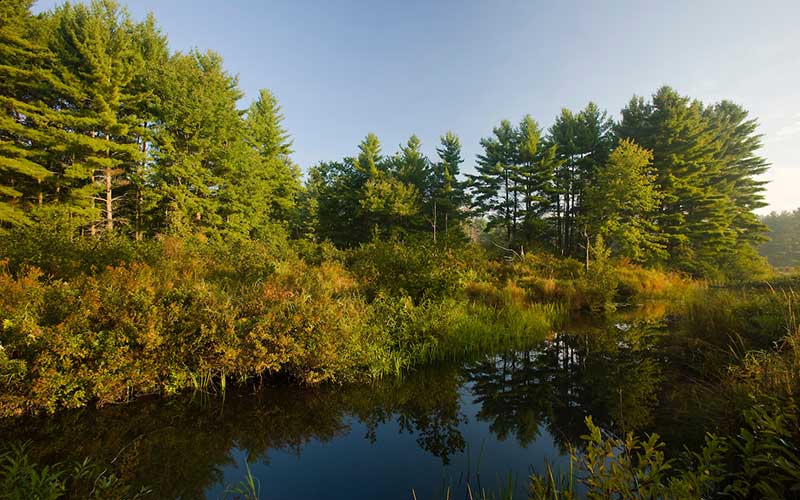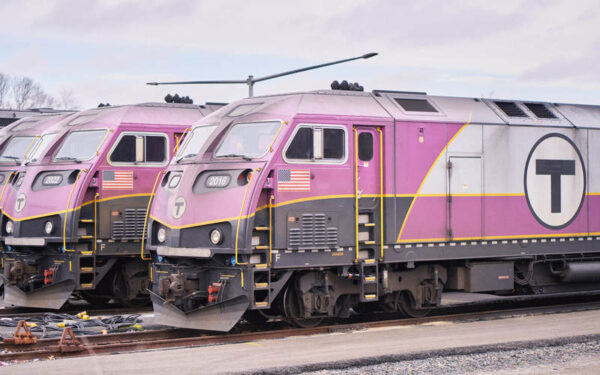
If Waste Management is allowed to expand its Turnkey landfill, any leaks from the site would end up in the Isinglass (above) and Cocheco rivers. Photo: EcoPhotography
As CLF’s Zero Waste Project director, I live and breathe solid waste. Specifically, I spend my days (and many nights) advocating for much-needed changes to dramatically reduce the amount of waste we generate in New England. I also work to ensure that the ways we dispose of waste – through landfills and incinerators, for example – doesn’t harm the health of our communities, pollute the environment, and undermine our ability to reduce waste in the first place.
That’s why I was shocked to learn about Waste Management, Inc.’s proposal to expand the massive Turnkey landfill in Rochester, New Hampshire. Already the largest landfill in New England, Turnkey fails on all three counts above – it’s already polluting the local environment and endangering the health of its neighbors. And expanding it will only make it harder to cut the amount of waste generated in New England overall.
Does New Hampshire Really Want Millions of More Tons of Garbage?
In 2016 alone, Waste Management accepted 1.4 million tons of waste at the Turnkey landfill – that’s almost as much waste as the entire state of New Hampshire generates annually. But only about 40 percent of the waste buried at Turnkey is actually from the Granite State. The rest – an estimated 850,000 tons in 2016 – is shipped there from out of state.
Turnkey landfill has enough room to operate at its current rate of waste disposal until 2024. Waste Management, which owns more than 1,200 acres of land in Rochester, is already planning to increase its yearly intake by 15 percent. That means that out-of-state waste alone would soar to about 1 million tons annually. And, the company has asked the New Hampshire Department of Environmental Services (DES) to let it increase its site footprint by 58.6 acres, which would add another 14 million tons of capacity on the site.
How does this benefit the people of New Hampshire? It doesn’t. It only benefits Waste Management’s bottom line. In fact, this expansion will put New Hampshire communities at even higher risk of harm from this dangerous facility.
All Landfills Leak Toxins – and Turnkey is No Exception
There are many reasons to worry about such a huge expansion, but at the top of my list is the risk to groundwater. Every landfill leaks eventually – the liner systems under buried waste are supposed to prevent leaks from happening for a while, but plastic liners deteriorate over time, and clay liners eventually become porous. And there’s no way to repair liners once they start leaking.
The liquid leaking from landfills is called leachate, and it’s contaminated with chemicals, heavy metals, volatile organic compounds, and pharmaceuticals, among other toxic substances. Since Turnkey has been operating since 1981, the first liners were most likely porous clay (Waste Management’s application for expanding the landfill is not clear, but clay liners were the norm in the early 80s). Groundwater monitoring done at Turnkey as recently as 2017 detected 1,4 dioxane, a known carcinogen, as well as perfluorooctanoic acid (PFOA) and perflluorooctanesulfonic acid (PFOS), both emerging toxins of concern linked to cancer and birth defects.
That means Turnkey is already leaking toxic chemicals that endanger human health into the groundwater – and now they want to dump millions of more tons of waste there? That alone should have us all shaking our heads in disbelief that New Hampshire DES hasn’t already rejected this proposal out of hand.
An Expansion Puts Two Rivers at Risk
What’s more, the proposed expansion area sits in the crook of the Cocheco and Isinglass rivers. According to Waste Management’s application for expansion, “The Isinglass River appears to be the primary discharge zone for groundwater over most of the proposed expansion. The easternmost portion of the proposed expansion appears to discharge to the Cocheco River.”
In other words, any leaks from the proposed expansion would end up in the two rivers. How is that okay? It’s not. It’s dangerous. And it must be stopped. While landfill operators and regulators like to pretend they can engineer their way out of this problem, the reality – again – is that landfills leak. Just as the Turnkey landfill is already leaking,
The Devil Is in the Details – Or, in This Case, the Lack of Details
For a company seeking to expand the largest landfill in New England by another 58 acres, one would expect a detailed application to New Hampshire DES – one that answers basic questions for the benefit of the public and regulators. I’ve been through all 2,200 pages of Waste Management’s expansion application. Incredibly, a whole host of relevant facts seem to be missing or buried, such as:
- How many acres does the landfill cover now?
- How high is it now?
- How tall are the proposed earth walls Waste Management would like to build to hold in waste?
If such fundamental facts are missing, what other information was left out that might be critical to understanding this facility and its future plans?
This Expansion Proposal Isn’t Public Enough
What’s more, the public process for commenting on this proposed expansion has been anything but robust. Only one public meeting has been held, and that was back in December. New Hampshire DES offered one public comment period, which closed in January (you can read CLF’s submitted comments here). To put that in context, were an expansion of this size proposed in Massachusetts, the local board of health would hold at least a dozen meetings before granting a solid waste permit. At least three or four comment periods from three different state agencies would be opened. And public meetings associated with those agency deliberations would be held as well.
No state should permit the expansion of a polluting landfill without robust outreach to and input from the public, not when its impacts on its neighbors have not been assessed fully and its current record of contaminating our groundwater ignored. We need more information – and New Hampshire DES must demand that Waste Management provide it. And we need to analyze that information to figure out precisely how and where the landfill is leaking now.
We Need to Reduce Our Waste, Not Find More Places to Bury It
Beyond the health and environmental impacts of the landfill, DES needs to explain just how Waste Management’s proposed 58-acre expansion does not completely undermine New Hampshire state laws that wisely favor reducing waste and recycling over waste disposal, and that relegate landfilling to the last resort. Then, and only then, should New Hampshire DES consider expanding this landfill.
New Hampshire and New England as a whole can and must do better. Failing to get a handle on waste – and continuing to pass health and environmental hazards along to future generations – is not an option. Unfortunately, expanding the Turnkey landfill would do just that.




